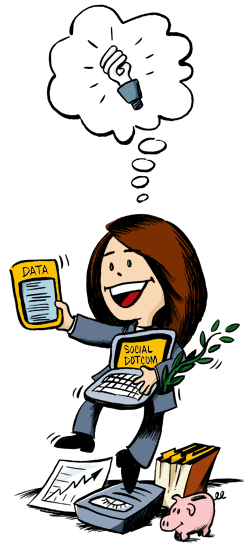
Everyone’s hurting right now and while you’re thinking you need to cut back on sales training, marketing and R&D, your biggest, baddest competitors have likely already done just that. Which means you have a unique opportunity to enter a new market or expand your existing share while the big boys aren’t looking. This is exactly what companies like Clif Bar, Method Products, Inc. and The Wine Group are doing.
Be Frugal In Your Design Decisions.
A great example of frugal design innovation is the development of Recession Wines by The Wine Group last year. They took advantage of recessionary wine purchasing trends (you know, the one where consumers drink more and cheaper wine at home than out and about with their friends) and created a low-price competitor to Two-Buck Chuck by saving money via packaging design. Using cheaper synthetic corks and a lighter bottle saved enough money per unit to allow offering a price under $5. This is a great example of using design frugality to achieve the lower price without skimping on the quality of the actual product.
And thanks to the up front legwork achieved by Two-Buck Chuck, consumers know that cheap wine doesn’t have to taste like floor cleaner. So new brands like Recession Wines don’t have to spend money changing consumer attitudes, they can instead focus on developing a great product and getting it to market.
Be Creative And Limber.
Limber up and be ready to try new things or take on the category gorillas like Method Products, Inc. did during the dotcom bust.
In 2001, after the massive dotcom failures, investors were afraid and ready for anything that wasn’t founded on questionable technologies. Using a friendlier logo, a more humanist approach overall, better design and easier, faster to read text allowed Method to take on the likes of P&G and SC Johnson. Method’s more casual and honest approach also tied directly into the green product trends consumers were starting to buy. These creative approaches, combined with truly green products, allowed Method to a get there faster and connect more quickly and firmly with consumers. Most importantly, it allowed them to compete more affordably during a recession when the 800-pound gorillas were asleep.
Seek Opportunities To Steal.
Most of your competitors will be scaling back their marketing programs to cut costs. They’ll even be laying off the people that watch out for companies like yours. This is your chance to steal more of the spotlight, and it will cost less to do so during a recession. Ad rates can be more favorably negotiated. Ditto with vendor costs. And don’t forget, any customers you snag during this difficult time will still be your friends when the market recovers.
This is exactly what happened when Clif Bars entered the market in 1992 and challenged Powerbar, the industry front-runner. Powerbar owned the market; there was no serious competitor. But with a recession in play, the field leveled and Clif Bar stole the ball.
Taking more care to research the market and spending more time in R&D allowed Clif Bar to create a much better tasting product and enter through bike shops rather than grocery outlets. Couple this with vendors so desperate for a sale they’d risk doing business with a start-up, and Clif Bar was in business.
Don’t Wait For An Invitation.
Experts think the recession is starting to wane, which means you don’t have much time left. So stop wasting paper and pixels on fluff, and focus on more human-to-human, conversational tones. Adjust both your visual and verbal messages to your customers. Their needs have shifted and so too should your messages. Ensure you’re meeting consumers’ design needs whether it’s larger type for boomers or less costly production materials for the newly unemployed.
Think beyond traditional media by considering social media tools to more directly connect to your target market. During a recession, many consumers are at home, in front of their computers, communicating through social networking tools. You should be there, too.
And certainly don’t skimp on communicating superior quality during a recession. Especially with high-ticket items that consumers will be married to for years to come. This is a time when they’re going to be especially critical of cheaper durable goods that could be a waste of their hard-earned dollars.
And above all, innovate as if your life depended on it, because in a recession, your company’s life does. Now go out there and get scrappy, dang it!
By Julia Moran Martz
 Get out more—develop a social media plan. It’s relatively inexpensive and moves you into a fast developing marketing arena. To get up to speed, check out
Get out more—develop a social media plan. It’s relatively inexpensive and moves you into a fast developing marketing arena. To get up to speed, check out 





